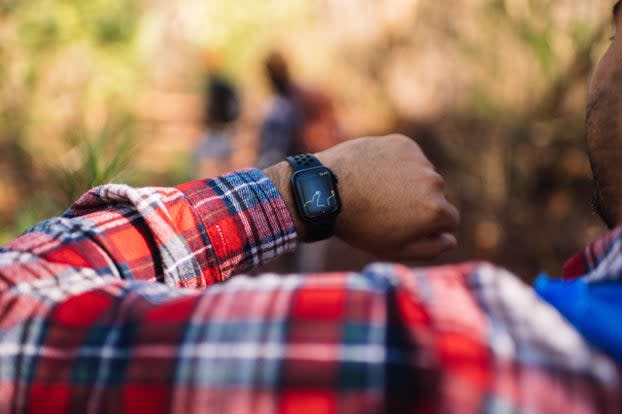Advanced Gaia GPS Navigation for Trail Runners
This is the second in a two-part series on Gaia GPS for trail runners. Find part one, “Beginner Navigation,” here.
Mountain athlete Kyle Richardson pedaled his loaded bike along a sand-tossed doubletrack road in southern New Mexico when he hit a deep dune that sent his back wheel sideways. He was riding the Monumental Loop, a 245-mile figure-8 across obscure singletrack, dirt roads, and sandy washes by the Organ Mountains. Richardson was participating in the annual DangerBird bikepacking event, where cyclists gather to complete the route. Richardson decided to pedal straight through with a lightweight setup: a 37-hour push with a few hours of sleep.
Other than two wheels, his primary tool was Gaia GPS, Richardson said.
"I downloaded the map, the route, and points of interest, including water resupplies and climbs, then turned my phone on airplane mode," he said. "I recorded my track and could zoom in-depth to where I was located in remote areas of desert or sections of braided roads to make sure I was on the correct route."
From bikepacking to exploring on two feet, Gaia GPS can help trail runners stay prepared, safe, healthy, and organized on long expeditions.
International Trips
On a recent overseas trip to the United Kingdom for the Kendal Mountain Festival, Richardson used Gaia GPS to research routes in the Lake District.
"Gaia [GPS] is the perfect tool to explore a new place," Richardson said. "I oriented myself online, downloaded GPX files from Strava and local races that I uploaded to Gaia [GPS], color-coded the routes, and then downloaded that data to my phone, so they were downloaded when I arrived."
He also toggled on the Public Tracks feature in Gaia GPS to see where popular running routes were located.

Study Technical Terrain
Professional trail runner Logan Greydanus uses Gaia GPS for pre-mission research.
"Gaia GPS is helpful for unknown situations, examining smaller geographical features, and making routes in advance, even in the mountains I am familiar with," Greydanus said. He used various map layers to determine how to approach a ridgeline traverse he recently completed between Snowmass and Hagerman Peaks, in the Elk Mountains where he lives outside Crested Butte, Colorado.
Similarly, Richardson used Gaia GPS to create a route and follow his track while setting an FKT on the LA Freeway, a ridge between Longs Peak and South Arapaho Peak, west of Boulder, Colorado.
"I wanted to know how long the ridge was. The stats--distance, vertical, and what it looks like on a map--were up in the air. Only one person had run it," he said.
RELATED: Map And Compass Navigation Is An Essential Trail Running Skill
Breadcrumb Trails
Similar to Richardson's DangerBird bikepacking mission, ultrarunner Nick Couts records tracks on his watch and in Gaia GPS as a security check.
"The app leaves a breadcrumb trail of the route you've traveled, and it's a nice visual reference," says Couts. "The feature is great for less-traveled areas where there are tons of cow paths or social trails beaten in more than the actual trail."
Share Trail Data
For undesignated routes, Greydanus uploads several GPX files of tracks for the same objective. He compares the routes side by side both while planning and while in the field.
"When I ski mountaineered Mount Rainier this spring, I picked five people I know that skied the route we were going to do, downloaded all of their tracks from Strava, and every time we were at a point of choosing where to go, we consulted the tracks," Greydanus explained.
Snap-to-Trail Feature
Gaia GPS offers a snap-to-trail feature for efficiency and accuracy: The route automatically snaps into place along the intended pathway. Premium members can access the snap-to-trail feature when out of cell service with downloaded maps.
"If you want to know a route's distance or elevation gain, you can open the Gaia GPS app at a trailhead, click on the trail, and by default it builds a path of least resistance," said Couts. "You just click before and after a junction. It's a huge time saver."
Map Layers
With a premium membership, trail runners can download hundreds of worldwide maps including Gaia GPS's proprietary Gaia Topo, with industry-leading download speeds and efficiency; weather overlays; United States Geological Survey grids; and National Geographic Trails Illustrated Topographic Maps.
"The Private and Public Lands map layers help me determine if the route is on private property or public lands, and if I'm in national forest, BLM, or wilderness area," said Greydanus.
Couts prefers the Fresh Satellite and Cloud Free layers, which provide recent satellite imagery. These maps include timestamps, so he can see if a trail or road has snow on it, especially during shoulder seasons. "You'll know if you need to abort mission, circumnavigate, or bring gaiters and spikes. It's great to eliminate surprises in higher elevations," said Couts.
Richardson's favorite layers include Air Quality and Native Lands. The latter allows him to see which Indigenous groups historically and currently live in the region where he's recreating.
Other helpful layers include precipitation overlays, avalanche forecasting, snow depth, National Park Service maps, Forest Service roads and trails, slope angle shading to conceptualize steepness, and historical maps to see old mine sites and ghost towns.
Customized Waypoints
Trail runners can drop photos and customized waypoints, using different emojis, symbols and colors, to remember specific sites.
"I like dropping pins for a boulder I want to go back and climb, cool campgrounds and bivy spots, ridgelines and couloirs, and nice meadows, which I can toggle off to declutter the map," said Richardson.
Gaia GPS is free with your Outside+ subscription. Find out more here!
